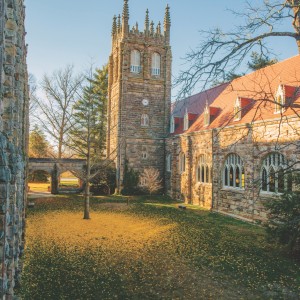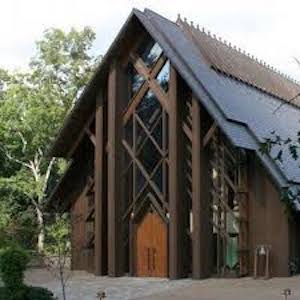Concerned by the failure of the Episcopal Church to establish a successful institution of higher learning within the southern states, 10 Episcopal dioceses agreed in 1856 to cooperate in creating a single university. Responding to their bishops’ invitation, clergy and lay delegates from Alabama, Arkansas, Florida, Georgia, Louisiana, Mississippi, North and South Carolina, Tennessee, and Texas met at Lookout Mountain near Chattanooga, Tennessee, on July 4, 1857, to name the first board of trustees.
On October 10, 1860, the ceremonial laying of a University cornerstone was completed, but plans were drastically altered by the Civil War, which erupted a few months later. In 1866, after the war, the bishop of Tennessee and the University’s commissioner of buildings and lands returned to the campus to re-establish the institution formally, but the money raised before the war was gone, the South was impoverished, and there was much to do before the University would open.
The first convocation of the University of the South was held on September 18, 1868, with nine students and four faculty present. At the time, the campus consisted of three simple frame buildings. Although years of struggle and adversity lay ahead, the University grew because many people, eager to participate in this challenging enterprise and willing to sacrifice for it, came to Sewanee.
The University’s history can be divided into several periods. The “second founding” in 1866 was followed by years of uncertainty during the Reconstruction era. But from the end of that period until 1909, the University experienced steady growth.
Rising expenses forced the University to close the departments of Dentistry, Engineering, Law, Medicine, and Nursing in 1909. However, the University was able to maintain its basic departments — a preparatory school, college, and seminary. Although the academic strength and reputation of the University grew, it lived with constant financial hardships.
The University shored up its ailing finances, undertook much-needed renovations, and emerged from the eras of the Great Depression and World War II well-equipped and prepared to enter its greatest period of growth. From 1950 to 1970, the endowment increased from just over $1 million to more than $20 million. Old buildings underwent major renovations, new buildings were constructed, and the school became coeducational in 1969.
During the seventies and eighties, a new student union and hospital were built and municipal services were modernized. These years were also characterized by a dramatic improvement in the financial condition of the University as well as a revival of religious life on campus. Moreover, the University’s three-year national capital campaign met and surpassed its $50 million goal.
From its opening in 1868 until 1981, the University included a preparatory school known successively as the Junior Department, the Sewanee Grammar School, the Sewanee Military Academy, and the Sewanee Academy. In April 1981, the Board of Trustees voted to merge the preparatory school with St. Andrew’s School on the St. Andrew’s campus, just outside the gates of the University Domain. This school, called the St. Andrew’s-Sewanee School, continues to provide quality education in an Episcopal setting.
From 2000-2010, under the leadership of Vice-Chancellor Joel Cunningham, Sewanee saw extensive growth in the physical campus, expanding enrollment, and successful fundraising. Dr. Cunningham led an administration at Sewanee characterized by fiscal discipline and a strategic planning effort that touched virtually every area of the University’s operations. During his tenure, Sewanee enjoyed record applications to the College of Arts and Sciences; a comprehensive program of renovation and new construction for academic, residential, and athletics facilities; growth in the influence and reach of the School of Theology; and increased recognition as a leading liberal arts university.
In 2010, John McCardell was elected the 16th vice-chancellor of the University. Over McCardell’s 10-year term, the University saw applications to the College of Arts & Sciences more than double, and a number of new facilities were added to campus via new construction or renovation, including: the new Sewanee Inn; two new residence halls; the Learning Commons in duPont Library; and the Wellness Commons, a building focused on student well-being and home to the University Wellness Center, a fitness facility, the Sewanee Outing Program, and an outpost of the University Bookstore. The University also began a process of investigating its historical entanglements with slavery and slavery’s legacies with the 2017 launch of the Roberson Project on Slavery, Race, and Reconciliation, named in honor of the late Houston Roberson, the first tenured African American faculty member at the College and the first to make African American history and culture the focus of their teaching and scholarship. In 2018, the University introduced the Sewanee Pledge, a three-part guarantee for every incoming student: funding for an internship or research opportunity, access to a semester-long study abroad program at no additional tuition cost, and graduation in four years or the fifth year is tuition-free.
Reuben Brigety, former U.S. ambassador to the African Union, was elected the University’s 17th vice-chancellor in 2020. During Brigety’s tenure, the University responded to the challenges of the COVID-19 pandemic by implementing comprehensive safety and testing protocols, including the opening of an onsite molecular diagnostics laboratory. Thanks to its coordinated efforts, the University remained open for in-person instruction for the duration of the 2020-21 academic year. Under Brigety, the University bolstered support for student success and named its first chief diversity officer. In 2022, Nancy Berner assumed the role of interim vice-chancellor following Brigety’s departure, and in so doing became the first woman to wear the vice-chancellor’s ermine.
The University elected Robert Pearigen as its 18th vice-chancellor in 2023. During Pearigen’s first months in office, work began on drafting a new strategic plan to chart the University’s course for the coming years. In 2024, the Board of Trustees formally adopted the first strategic plan for the University in 12 years—Elevating Mind, Heart, and Place: the Strategic Plan for the University of the South 2024-2030. Building upon the University’s rich liberal arts and theological education tradition, the plan is animated by two underlying objectives: providing a comprehensive curricular offering that will sustain the University’s attractiveness to a larger number of high-caliber students; and, preparing students for lives of service and leadership so they will become active citizens contributing to democracy at home and the resolution of challenges around the world.

